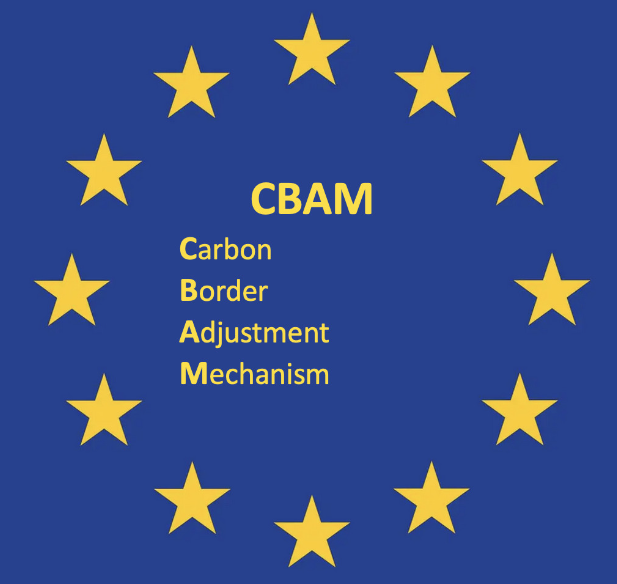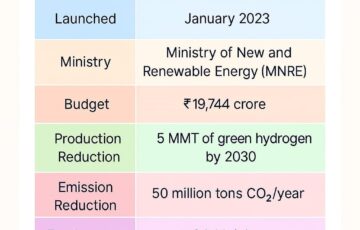EU’sCarbon Border Adjustment Mechanism (EU-CBAM)
Syllabus:
GS 3: Environment
Why in the News?
European Union’s Carbon Border Adjustment Mechanism (EU-CBAM) has generated global controversy, particularly at COP29 in Baku, as developing countries, including India, condemn it as discriminatory.
Introduction
- European Union’s Carbon Border Adjustment Mechanism (EU-CBAM) has stirred a global debate on protectionist measures veiled as climate action.
- Framed as a way to address carbon emissions, developing countries like India see this as discrimination that shifts responsibility, undermines equity and prevents fair trade in a global battle against Climate Change.
CBAM: discriminatory instrument against developing countries
- European Union Carbon Border Adjustment Mechanism (EU-CBAM) has caused serious concerns in developing countries including India.
- While it is described as a framework for addressing climate change, it is widely seen as a discriminatory tool that disproportionately affects the exports of developing countries and is critical of global trade.
CBAM: Features
- Import duties on carbon emissions: CBAM ensures that import duties on carbon emissions are equal to those imposed on EU-produced goods.
- Exporters must provide detailed information on the emissions associated with their products and proof of purchases in line with those emissions.
- Implementation Timeline: ultimate phase of the CBAM is set to begin on January 1, 2026, with a significant impact on international trade.
How it will influence in India?
- EU market access: EU accounts for 33% of India’s total exports.
- About 25.7% of these exports fall under CBAM, covering industries such as iron, steel, aluminium, cement and fertilizers.
- Regional weaknesses: Iron and steel accounted for 76.83% of exports touching the EU in the last five financial years, followed by aluminium, cement and fertilizers.
India a critique of CBAM
- CBAM labeled as “discriminatory”: India has called CBAM “arbitrary and discriminatory” and urged developing countries to take solidarity action against this unjust shift of responsibility.
- Danger of weak arguments: An unstructured debate at COP29 in Baku could undermine India’s credibility as a global South leader in climate negotiations.
Challenges for developing countries
- Economic aspirations: Many developing countries do not share same as India’s economic objectives or face the same impact from CBAM.
- Multilateral and bilateral trade relations further complicate perceptions of CBAM.
- Emission Accounting Principles: Under the UNFCCC production-based accounting principle, exporting countries are responsible for the disposal of production but not consumption.
- This measure increase burden on developing countries with stronger obligations, especially those with more robust mechanisms to reduce emissions and transfer more abroad.
Arguments Against CBAM
- CBAM approach introduced by the European Union (EU) has created many concerns for developing countries including India.
- India’s arguments against CBAM effectively must align with the broader interests of developing countries and focus on fairness, equity and fairness.
The main arguments advanced by India are as follows:
1. Lack of preparation time
- European Union launched its Climate Action Strategy in 2008, setting a goal of reducing greenhouse gas (GHG) emissions by 20% by 2020 compared to 1990 levels that
- After addressing this, the 2019 European Green Deal extended the emissions reduction target to 55% under the 1990 Fit for 55 Package.
Injustice to the developing world
- EU’s operational preparation takes more than a decade, giving its industries enough time to adapt to emissions reduction requirements.
- Developing countries like India do not have the same timelines and resources, which raises the question: does CBAM allow sufficient time for developing countries to adapt?
2. Inequality in Revenue distribution
- EU plans to save an estimated €5 to €14 billion per year by 2030 from CBAM.
- This funding will primarily support the NextGenerationEU recovery mechanism and run CBAM itself.
Non-EU partners excluded
- Developing countries whose exports contribute to CBAM revenues do not benefit from these funds.
- India could argue that an equitable approach would involve sharing CBAM revenues with non-EU trading partners.
- These shared funds can support capacity development, technology transfer, and emission reduction efforts in developing countries.
3. Emission Liability: Call for Inequality
Equity Based Accounting (EBA)
- India can advocate equity-based accounting (EBA) for nationally defined contributions (NDCs).
- The EBA enforces trade partners’ obligations to reduce carbon emissions by:
- Horizontal equity (horizontal equity of countries with similar powers).
- Vertical parity (greater responsibility to wealthier countries with higher historical emissions).
EBA payment system
- India could propose an EBA mechanism for calculating tariffs on EU imports, which includes:
- GDP per capita.
- that of per capita emissions.
- lower profit margins.
- Relative avoidance of emissions by trade.
Unbiased Climate Analysis
- This approach reflects historical and developmental differences between countries, in order to ensure appropriate climate action regulations for developing countries.
4. Violation of principles of climate justice
Justice ignored in CBAM
- CBAM ignores the principle of common but differentiated responsibilities and related competencies (CBDR-RC) under the UNFCCC framework.
- It fails to recognize compensatory justice or distributive justice, which takes into account the historical contributions of climate change and mitigation capacity.
EU tactics
- CBAM appears to force non-EU countries to align themselves with the so-called EU climate leaders, undermining the sovereignty and priorities of developing countries
Conclusion
EU’s CBAM raises fairness and equity concerns, especially for developing countries. India should support collaborative, justice-driven solutions to global climate challenges without compromising development aspirations.
Source: The Hindu
Mains Practice Question:
Protectionist climate policies like the EU-CBAM undermine global climate cooperation and unfairly shift responsibility to developing countries.” Critically evaluate this issue more closely in the context of India’s position at COP29 and global climate diplomacy.





